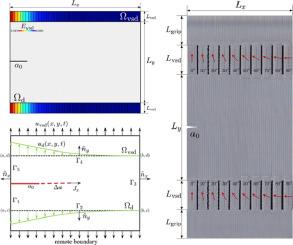确定非均质材料有效韧性的变刚度边界条件
IF 7.3
1区 工程技术
Q1 ENGINEERING, MULTIDISCIPLINARY
Computer Methods in Applied Mechanics and Engineering
Pub Date : 2025-09-26
DOI:10.1016/j.cma.2025.118414
引用次数: 0
摘要
本文提出了一种结合变刚度边界条件(VSBC)和相场模型的计算框架来评估非均质材料的有效断裂韧性。它建立在所谓的冲浪边界条件(SBC)上,该条件利用远边界的非均匀位移来稳定非均匀介质中的裂纹扩展。与SBC不同,VSBC很容易在传统的通用测试机和商业软件包中实现。VSBC通过工程刚度梯度被动地将简单、均匀的远程位移转化为非均匀载荷,使裂缝沿着能量有利的路径稳定、自然地扩展。该框架在均质材料上进行了验证,计算的j积分与规定的断裂韧性精确匹配。当应用于非均质领域时,VSBC方法成功地量化了由于刚度和韧性对比而增加的有效韧性,并捕获了从裂纹渗透到挠曲的关键转变。使用3d打印样品的实验验证证实了该模型的预测能力。VSBC框架为研究复杂材料的断裂提供了一个强大且易于使用的工具,并指导设计先进的抗断裂复合材料。本文章由计算机程序翻译,如有差异,请以英文原文为准。

Variable stiffness boundary condition to determine effective toughness of heterogeneous materials
We present a computational framework that combines a variable stiffness boundary condition (VSBC) with a phase-field model to evaluate the effective fracture toughness of heterogeneous materials. It is built on the so-called surfing boundary condition (SBC) that applies nonuniform displacement at the remote boundary to stabilize crack-propagation in a heterogeneous medium. Unlike SBC, VSBC is easily implementable in traditional universal testing machines and commercial software packages. The VSBC passively translates a simple, uniform remote displacement into a non-uniform load via an engineered stiffness gradient, enabling the stable, natural propagation of cracks along energetically favorable paths. The framework is validated on homogeneous materials, where the calculated -integral precisely matches the prescribed fracture toughness. When applied to heterogeneous domains, the VSBC method successfully quantifies the increase in effective toughness due to stiffness and toughness contrasts and captures the critical transition from crack penetration to deflection. Experimental validation using 3D-printed samples confirms the model’s predictive capability. The VSBC framework provides a robust easily accessible tool for investigating fracture in complex materials and guide the design of advanced, fracture-resistant composites.
求助全文
通过发布文献求助,成功后即可免费获取论文全文。
去求助
来源期刊
CiteScore
12.70
自引率
15.30%
发文量
719
审稿时长
44 days
期刊介绍:
Computer Methods in Applied Mechanics and Engineering stands as a cornerstone in the realm of computational science and engineering. With a history spanning over five decades, the journal has been a key platform for disseminating papers on advanced mathematical modeling and numerical solutions. Interdisciplinary in nature, these contributions encompass mechanics, mathematics, computer science, and various scientific disciplines. The journal welcomes a broad range of computational methods addressing the simulation, analysis, and design of complex physical problems, making it a vital resource for researchers in the field.

 求助内容:
求助内容: 应助结果提醒方式:
应助结果提醒方式:


